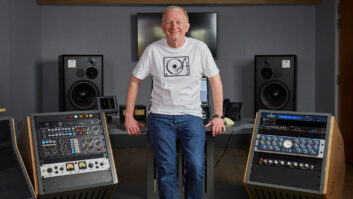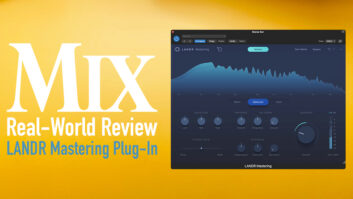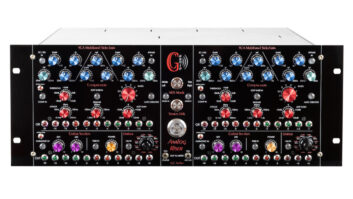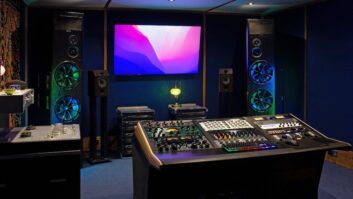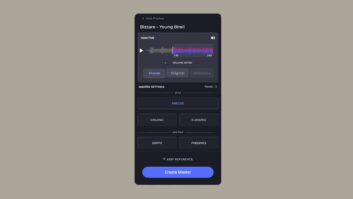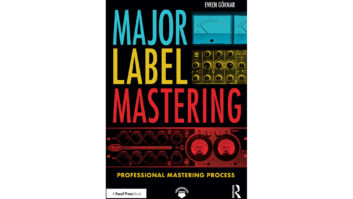In this brave new world in which plug-in processors have quickly come to the forefront, the TC Electronic System 6000 hardware unit has maintained its prominence in the audio workplace. This is due in large part to its scalability. With the advent of the new 3.5 operating system, users potentially have a fully loaded system that can be upgraded at will by a simple challenge/response system.
The new M6000 Mastering package is targeted to the mastering engineer’s needs. The new tools work in mono, stereo, LCRS, 5.1, 6.1 or 7.1, with additional cascading of the four internal engines for extended formats (8.1, 10.2, etc.).
HARDWARE OVERVIEW
The Mastering 6000 hardware comprises three major components. The Mainframe is a 2U box that houses the DSP and three optional I/O cards. The ICON is a touch-sensitive TFT active matrix color LCD (640×480 pixels) and moving-fader remote control. The ICON is an optional, but highly recommended, accessory. In its absence, the M6000 comes with software so it can be operated from a Mac or PC. Last is the Remote CPU, a Windows NT-compatible computer housed in a 1U frame whose primary function is to run the ICON.
Minimum physical I/O configuration is eight AES/EBU via a DB25 connector housed on the DSP6000 card. Additional I/O in the remaining three slots can be configured with the AD/DA cards, each having two channels of balanced analog I/O on XLR connectors or one additional digital card — the AES-8 — which has four channels of AES/EBU I/O on XLR connectors. One AES-8 card can be installed, while AD/DA cards can be installed in any remaining slots. My unit was configured with the required DSP6000 and three AD/DA cards, for a total of eight AES/EBU I/O and six balanced analog I/Os.
If you’re familiar with how the System 6000 operates, then you’ll fall right into lock-step with the new algorithms. Once configured, ICON’s FRAME screen shows routing, algorithms and levels. The entire screen becomes a relative metering system, displaying signal at the physical input, the processor input, processor output and physical output. Hit the Route button, and you get labels for every input and output.
STEREO TOOLS
The Mastering 6000 includes stereo and multichannel licenses for a number of algorithms. The stereo package includes the MD3 multiband dynamics processor, which is the successor to the M5000’s MD2 dynamics processor. It uses a 3-band compressor, expander, limiter and 4-band parametric equalizer — all in a single algorithm. It can run in stereo or dual-mono configurations. Stereo signals can be processed conventionally or in MS mode, and an MS signal can be converted to stereo. The limiter uses an “overshoot-proof micro-delay” to avoid any samples exceeding the threshold.
Next is the MD4 multiband dynamics, featuring five bands of compression, the DXP (expansion) mode used to lift up low-level detail and a 4-band parametric EQ. The compressor has three different configurations: Normal mode operates like a standard downward compressor until a second threshold is reached, at which point, the limiter kicks in. Parallel mode mixes the compressed signal with the dry signal (complete with delay-compensated primary path dry signal). DXP Mode is designed to enhance subtle details without boosting portions of the audio that are already loud enough in the mix. This process can be applied to the M and S portions of the stereo signal individually.
The three modes use 48-bit fixed-point processing. The EQ section uses 48-bit fs/2 analog modeling, regardless of the M6000’s set sample rate; i.e., you can input a boost at 24 kHz and the signal will be effected within the bandpass of the current sample rate limitations. In MS mode, mid and side can be EQ’d separately, offering the same operational flexibility as the compressor.
Rounding out the group is Brickwall 2 and De-Esser. Brickwall 2 is an “investigative tool” designed to analyze the incoming signal and detect any samples above 0 dBfs and remove them. It can even be used on previously mastered material to remove intersample peaks associated with the overuse of loudness maximizers. The De-Esser’s 100 to 20k Hz bandwidth makes it suitable for de-popping and frequency-dependent limiting in the sibilant range.
MULTICHANNEL TOOLS
The MD3, MD4, Brickwall 2 and De-Esser are enabled for multichannel use. The system also offers the MD 5.1 (5.1-channel dynamics processor), a 3-band compressor, expander and limiter in one algorithm.
The Toolbox 5.1 features level, test and bass management, as well as a downmix conversion option, providing precise monitoring of your surround mix in mono, stereo, LCRS and 5.1. The Toolbox also provides speaker solos, mutes and reference levels for various listening environments.
Lastly, the EQ 5.1 — a 6-channel 4-band equalizer — offers different linking options, parametric, shelving and notch selectors, as well as Butterworth- and Bessel-type filters. The range for the notch is -100 dB to 0 dB, with the bandwidth selectable from 0.02 to 1 octave. The shelf can be set to 3/6/9/12 dB, allowing you to adjust the slope and gently reproduce the Baxandall curve or conventional console-style plateaus.
IN THE 5.1 STUDIO
TC Electronic has extensively researched the characteristics of source audio to develop “profiles” that work well with specific types of material, given the spectral information and dynamic range. For instance, the Brickwall 2 has dynamic, soft, universal, loud and voice profiles that are good starting points for classical music, acoustic music, pop music, distorted music (read: hard-core) and aggressive voice material, respectively. The timing, phase, threshold, etc., can be altered after the initial profile is selected.
I used the Brickwall 2 on several different sources, including soft voice and piano, choirs and a pop band track (Rhodes, drum kit, synths, distorted guitars, bass, vocals). Original sources were recorded on a Pro Tools|HD2 system running through a 192 I/O using both 16-bit/44.1kHz and 24-bit/88.2kHz files. The transparency of this software is beyond question: You really have to push the parameters into the silly zone to hear the time smear and the pumping. Yes, if you are looking for loud, you can make it loud. The point is, the company has given you a very fine polish that can be used with discretion and finesse. Numerous processors will give you loud; the M6000 gives you precision.
The MD4 algorithm’s DXP mode worked exactly as stated: It gently raised the lower-level dynamics of acoustic guitars and delicate bells, bringing them more in focus with the rest of the mix. Once the crossover points were set for the multiband compressor, a distinct harshness around 5 kHz was brought down in level on the huge Broadway choir recordings. In Parallel mode, the desired result of punching up the low end on a pop recording without adding loudness to the rest of the track worked very well.
When I used the De-Esser, the sibilant frequency on a female vocal track was easily found with the sidechain monitoring and surgically removed, leaving the surrounding frequencies intact.
The MD 5.1 and EQ 5.1 worked as well as the others — with precision, clarity and virtually indecipherable time shift and artifacts. I did not find any ringing when using the EQ. This is a linear phase EQ, eliminating the phase distortion created by the signal delay associated with conventional analog EQs. Operating the EQ screen takes some getting used to as you must select the Frequency screen, then the Gain, then the Q; all parameters are not available at the same time on the same screen as with most software EQs. It is not a huge effort to toggle between them, and operation becomes second nature in short order. The MD 5.1 perfectly tamed a pair of slightly hot vocal “answer” tracks in the surrounds without effecting the other channels.
MASTER OF THE UNIVERSE
The M6000 is a pleasure to operate. During the course of this review, it was difficult to pinpoint any inadequacies within the system. Ergonomically, it is easy to navigate and sonically beyond reproach. As for the base system, the outstanding AD/DA converters include a virtually jitter-free DAC and what some say is the quintessential internal clock included at no extra charge. There is a reason that this device is used by the finest ears in the business: It is a precision tool that, in the hands of an experienced mastering engineer, will give results that will turn a well-mixed record into a polished, marketable product.
Prices for the Mastering 6000 start at $7,995 (MSRP); mainframe with eight channels of AES/EBU I/O, stereo and multichannel dynamics, EQ, matrix and software editor are included. The optional ICON remote lists for $3,250.
TC Electronic, 818/665-4900, www.tcelectronic.com.
Bobby Frasier is a digital audio product specialist, professional audio consultant and educator.
